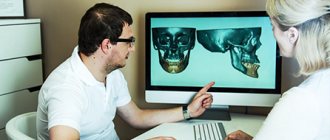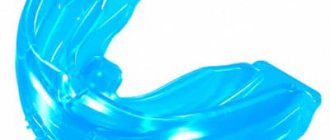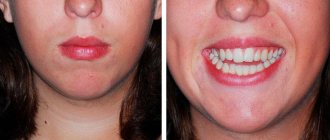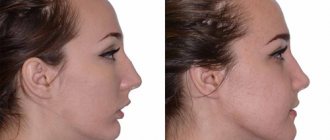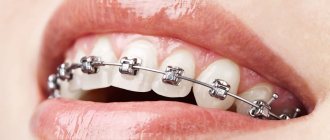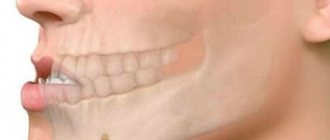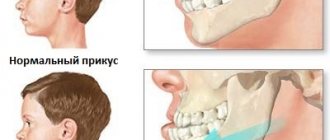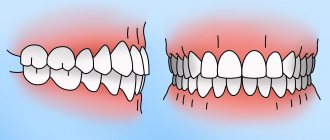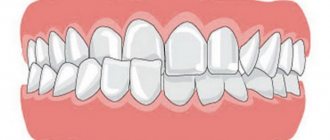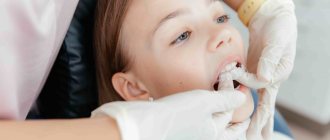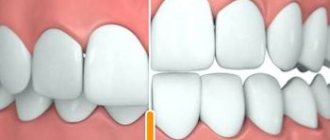Orthodontics is a branch of general dentistry that studies the paths of occurrence, methods of diagnosis, prevention and treatment of dentofacial anomalies. The object of consideration of this science is disorders that appeared in the process of formation of the chewing-speech system.
This section of dentistry was formed relatively recently, but the high demand for orthodontists has led to the fact that such specialists work in almost every dental clinic, so consultation with a doctor with this specialization is available to almost every person.
Indications and contraindications for bite correction
Indications:
- Incorrect location of dental elements (displacement or rotation around the axis)
- Crowded teeth
- Large interdental spaces
- Displacement of the jaws relative to each other
Contraindications:
- AIDS, HIV
- Tuberculosis
- Blood or bone diseases
- Oncology
- Diabetes mellitus and thyroid pathologies
- Serious mental disorders
Important: contraindications to orthodontic treatment are identified by a specialist according to the patient. Therefore, you should definitely inform your doctor if you have any health problems. The desire for ideal occlusion can result in deterioration of health for a person burdened with the listed diseases.
Why is there a need to seek medical help?
Among the causes of malocclusion and other types of dental disorders:
- genetic predisposition;
- bad habits in infancy (for example, prolonged use of a pacifier, feeding a newborn through an irregularly shaped nipple with a large hole);
- frequent viral and infectious diseases;
- abnormal width and length of the tongue.
Doctors can determine why the problem occurs by performing diagnostic tests. It includes an oral examination, x-rays, and a survey.
The essence and methods of orthodontic correction
The goal of treatment is to physically move the elements of the dentition into the desired position or change the position of the jaws.
The essence of the process is the creation of a driving directional force that is able to move the teeth and jaws into the correct position. To generate such a physical impact, there are several methods and devices used in the arsenal of orthodontics:
- myogymnastics;
- records and trainers;
- aligners (dental aligners);
- bracket systems;
- surgical intervention.
Note: the choice of a specific option is made by an orthodontist after a thorough diagnosis. The examination is carried out visually and using diagnostic equipment. The most informative are studies using a computed tomograph (3D image of the jaws and facial skeleton) and telex-rays. These methods allow the doctor to assess the condition of the dentofacial apparatus and the anatomical features of the joints, teeth and their roots, bone and soft tissues.
Directions
Orthodontics is a multi-level science that examines the process of development of the chewing-speech system from different points of view. The formation of the dentofacial apparatus takes a long time and goes through many stages. It begins immediately after the laying of the germ layers in the embryo, and ends at the age of 18-20 years. But even a formed system with a permanent bite can continue to change under the influence of internal (diseases, age-related changes, etc.) or external factors (ecology, consumption of aggressive ingredients, injuries, etc.).
Orthodontists correct malocclusion
Two periods are considered when dental anomalies may occur:
- Intrauterine. Disorders arise due to genetic predisposition, diseases suffered by the mother during pregnancy, her use of medications or drugs with severe side effects, random mutations, etc. The influence of external factors during this period is minimized.
- Postnatal. This period begins immediately after childbirth and is characterized by the fact that external factors come first for the development of disorders. Bad habits, the wrong type of diet, and lack of dental treatment can initiate the appearance of anomalies or cause those that are genetically determined to manifest themselves more strongly.
Orthodontics studies the following anomalies:
- Changes in jaw size: macrognathia (sizes larger than normal) and micrognathia (sizes smaller than normal).
- Abnormal position of the jaws: prognathia (excessive protrusion forward), retrognathia (posterior displacement), asymmetry (difference in the shape or size of the right and left side of the jaw bone) and inclination (shift relative to the base of the skull).
- Malocclusions – distal, mesial, deep, open, crossbite, excessive overjet.
- Changes in the dental arches - flattening, size anomalies (increase or decrease).
- Anomalies of individual teeth - an abnormal number (complete absence, more than it should be, and lack of dental elements), abnormal shape, impaired eruption, inclinations, crevices, crowding, etc.
Stages of treatment
Orthodontic therapy involves several stages:
- diagnostics (visual and hardware);
- selection of an orthodontic device and development of a treatment regimen;
- sanitation of the oral cavity (elimination of dental and periodontal diseases, professional cleaning);
- installation of the selected fixed appliance on the patient’s teeth (or familiarization with the principles of fixing removable devices);
- wearing an orthodontic device;
- removal of the device;
- retention stage to consolidate the achieved results.
Attention: the duration of the main and retention stages is set by the attending physician depending on the characteristics of a particular case. Failure to follow the recommendations may result in the teeth returning to their previous position.
Retainers used in orthodontics
In addition to the well-known braces and plates, orthodontists often use removable, non-removable retainers. Both types are needed to preserve the vacated space and prevent the displacement of “neighbors”.
It looks like this: loops are put on the teeth adjacent to the empty area. A rigid wire arch passes between them. It is this that prevents unnecessary displacement.
Retainers are installed both for primary and permanent occlusions. In the first case, they are needed until the root unit begins to erupt; in the second, until the patient decides to make a dental prosthesis.
Today, orthodontists have a large number of special corrective devices. This allows them to achieve positive dynamics even in advanced and seemingly hopeless cases. For treatment to be successful, the patient must accurately follow all medical prescriptions and in no case remove the corrective system ahead of time.
Myogymnastics
This correction method is functional and involves training the facial and chewing muscles that keep the jaw system in the correct position. The exercises are effective when the child is between 3 and 5 years old. At an older age, myogymnastics is used as an additional method of correction, i.e., simultaneously with wearing removable or fixed orthodontic devices. The condition for the effectiveness of using the described method is the regularity of the exercises. Therefore, the main burden in treating young children falls on their parents.
Required qualities
We figured out what an orthodontist treats and how to become one, but in this profession, in addition to professional skills and knowledge, human qualities and certain character traits are also important. The course of orthodontic treatment usually takes from one to several years, during which the doctor will have to regularly meet with the patient, and this will require building a trusting relationship with the person.
Trusting relationships and professionalism are the key to successful treatment
Thus, a good orthodontist should not only be a first-class professional, but also a sociable, efficient and patient person. He must be able to win over the patient, calm him down and set him up for successful treatment, which for him can already result in serious stress, especially if we are talking about a child or teenager.
Share in the comments, have you ever had to communicate with an orthodontist? How do you evaluate him and what qualities do you value in this specialist? Your opinion will help many other patients decide on the choice of a first-class doctor.
Notice
: Undefined variable: post_id in
/home/c/ch75405/public_html/wp-content/themes/UltraSmile/single-item.php
on line
45 Notice
: Undefined variable: full in
/home/c/ch75405/public_html/wp-content /themes/UltraSmile/single-item.php
on line
46
Rate this article:
( 6 ratings, average: 5.00 out of 5)
malocclusion
Records and trainers
These devices are removable. Plates are used in children during the period of primary and mixed dentition. The design consists of a polymer plate adjacent to the upper palate, with a metal arch built into it, which is fixed to the teeth. Some models have elements that allow you to change the size of the record. Samples of plates for children under three years of age resemble a pacifier. Details of this design prevent the jaws from closing incorrectly. Trainer
is an orthodontic mouthguard for both jaws, on the inside of which grooves for teeth are applied. When putting on the trainer, the dentofacial apparatus takes the correct anatomical position, the muscles get used to this state (“train”) and subsequently themselves hold the jaws in the desired position.
From the experts
In addition to all the above recommendations, experienced orthodontists offer a number of tips based on practical observations:
- For adults, before installing braces, it is better to remove their wisdom teeth, even if they have not yet erupted, since there is a high risk of them being damaged by caries;
- When choosing a doctor, make sure that the examination is thorough. If the orthodontist suggests putting on braces right away, this is a bad sign. However, another recommendation indicates the low qualifications of the specialist - he suggests waiting to start treatment. Most likely, he does not understand how to solve your problem;
- it is very important to treat all teeth before correcting the bite; in addition, you must learn how to clean them correctly so that while wearing braces the enamel does not become caries;
- Soft tissue adjustments may be required before treatment. You should not be afraid of this; if the doctor suggested performing the procedure, then it is really necessary.
Skeptics believe that correcting a bite in adulthood is useless, and braces are only effective on children’s teeth. This is not a completely correct opinion, but in some ways they are right:
- more significant pressure has to be exerted on the teeth of an adult, which leads to painful sensations at the initial stage;
- some teeth have to be removed to make room for others;
- Bridges and crowns have to be removed during treatment, which also does not add pleasant moments to the procedure.
Aligners (aligners)
Aligners
– a progressive and quite comfortable method of correcting pathologies of the dental apparatus of minor and moderate severity. This is a transparent plastic product that is worn over the teeth. For each patient, several sets are individually manufactured, each of which differs from each other by a slight change in geometric parameters. The patient independently changes the aligners in accordance with the treatment regimen, the teeth gradually move into the desired position. The most relevant models are those specially designed for children and adolescents, for example, FlexiLigner (“flexics”) and KidsLight, as well as universal Invisaling aligners.
Why do you need to treat malocclusion?
There are three main reasons:
- Crooked teeth make a person worry about their appearance. He is embarrassed to smile and tries to keep his mouth closed all the time.
- Curvatures contribute to the emergence and progression of a number of diseases of the respiratory and digestive systems. In the first case, the threat is due to breathing problems, in the second - due to poor chewing of food.
- Units growing at the wrong angle can put unnecessary pressure on their neighbors and injure the gums and tongue. In some cases, dental disorder causes adentia.
- Crowded areas cannot be cleaned properly. Plaque accumulates there, which provokes gum inflammation.
And these are not all the reasons. Today it has been proven that with some types of dental curvatures, the first cervical vertebrae can become displaced. Possible cerebrovascular accident. Uneven teeth mean an increased risk of heart attack, stroke, and hypertension.
Braces
Fixed orthodontic structures. They are classified according to several defining characteristics:
- positioning location. They can be vestibular (fixed on the outer side of the dentition) and lingual (installed on the inner side);
- method of attaching the power arc to the bracket pads. They are divided into ligature (fastening using ligatures - plastic rings or wires) and non-ligature (attached with small clip-locks);
- material of manufacture. The most popular are metal and ceramic products.
According to experts, the following models are considered the most popular:
- lingual non-ligature metal: WIN, INCOGNITO;
- vestibular non-ligature metal: Damon Q, H4;
- vestibular non-ligature ceramic: Damon Clear;
- vestibular metal ligatures: Biomim, Victory;
- vestibular ligature ceramic: Advanced, Hype.
Gum recession
Gum recession or exposure of the neck of the tooth root is a fairly common problem in orthodontic treatment. For example, treating severe crowding without extraction can lead to gum recession. The dentition expands and enlarges, but the bone base remains unchanged. In this case, partial or, in particularly difficult cases, complete exposure of the tooth root is possible. The contour of the gum changes, the teeth become visually longer. Sensitivity of teeth appears, reaction to sour, sweet, cold, hot. In addition to poorly planned orthodontic treatment, gum recession is caused by poor dental hygiene, tartar, and subgingival deposits. Therefore, when correcting a bite with braces, I recommend performing professional AirFlow hygiene at least three times during the entire treatment period. Before installing braces, in the middle of treatment and after removing the system. In addition, before starting to correct the bite, I teach personal hygiene while wearing braces and consider the patient’s compliance with the rules of dental hygiene to be a fundamental point in the prevention of possible oral diseases. Gum recession is fixable. The most common and reliable treatment for recession is surgery or gum grafting. And to be absolutely precise - the lateral flap method. A flap of healthy tissue is taken from the gum or hard palate adjacent to the affected area and sutured to the site of recession. The operation is performed under local anesthesia. Safe and relatively painless. The patient may experience tolerable discomfort in the area of intervention for a short time, but due to the fact that the tissues are completely identical, healing proceeds quickly and without complications.
Surgery
This method is used in very complex cases when other methods cannot guarantee the effectiveness of the correction.
These are the situations:
- the dental arch(s) are significantly deformed;
- There is a serious disproportion between the upper and lower jaws.
Surgery is necessary to form the correct position of the jaw bones and rotate the teeth around their axis. Often surgery is performed as a preparation for a hardware course of therapy. For example, removal of excess teeth in order to create free space for the movement of teeth, plastic surgery of the frenulum of the tongue.
Diagnostics
Diagnostics is crucial for successful bite restoration. At the first appointment, the orthodontist conducts an oral conversation, during which he finds out how the pregnancy proceeded, what type of feeding was used in the infancy period, when the baby teeth erupted, if the set is incomplete, why the loss occurred, whether there are any bad habits, etc.
The doctor must conduct a visual examination. He pays attention to the shape of the palms and hands, the shape of the head - this will give him an idea of systemic disorders of the musculoskeletal system. In addition, the specialist examines the contours of the face, lips, chin, identifies facial asymmetries and carefully examines the oral cavity.
The doctor palpates the temporomandibular joints and ears. It determines whether there is tenderness when pressing, clicking and deformation.
To clarify the diagnosis, the orthodontist writes out directions for the following types of examination:
- symmetroscopy - study of the shape of the dentition;
- teleradiography - a photograph of the skull from the front and from the side;
- electromyotonometry – measurement of facial muscle tone;
- fluoroscopy;
- MRI images of the temporomandibular joint.
In addition, it may be necessary to take photographs of the patient’s face in different projections and make a diagnostic model of the jaw bones. After completing the diagnosis, you can plan measures to normalize the bite.
How is the cost of orthodontic therapy determined?
The price of an occlusion correction course for different patients can vary significantly.
The final cost depends on the following factors:
- volume of diagnostic studies. Thus, diagnostics for therapy using aligners and plates are much cheaper than those when planning treatment using braces;
- the type of therapy chosen by the doctor (plates, aligners, braces);
- models of orthodontic apparatus. The cost of products may vary significantly;
- complexity of the clinical case. The more complex the defect, the longer the treatment will take.
When to start treatment: recommendations from orthodontists
- If you notice that you or your child have problems with tooth growth or closure of the dentition, then you need to visit an orthodontist. This is a specialist who diagnoses and treats orthodontic problems.
- The child should be shown to a specialist even if there are no visual signs of orthodontic disease. This should be done at 3–4 years of age, when the so-called “deciduous” bite has formed, i.e. all (or almost all) milk teeth have erupted.
- Orthodontic treatment should begin as early as possible. Even if the baby is still small and it is too early for him to get braces, you can start correcting the bite in other ways, which were mentioned in this article. It is possible that after the therapy, the use of more serious methods will not be necessary.
- Orthodontic treatment can be initiated at any age, even in adulthood. The effect will be achieved, only the duration of therapy will increase. This is due to the fact that after the formation of the skeleton is completed, the bone tissue becomes less elastic, so the movement of teeth in a given direction will be slower.
- Regardless of age, the patient must be psychologically prepared for a long and not always comfortable process. Having a positive attitude and motivation is the key to achieving the desired result.
Dental offers orthodontic treatment services in Moscow in one of its branches. We provide payment in installments for a course of therapy to correct the bite, and issue the necessary medical documents for processing personal income tax deductions. Our orthodontic specialists have high medical qualifications and improve their professional level in leading Russian and European dental clinics.
Branches of our orthodontic center are located in Moscow within walking distance from the metro:
- Art. Alekseevskaya (VDNKh district, etc. Mira), address: st. 3rd Mytishchiskaya house 3, building 2;
- Art. Shelepikha, address: Shelepikhinskaya embankment, address: building 34, building 1.
Pathology of teeth position or bite formation is not a death sentence. We are ready to begin treatment, regardless of the complexity of a particular clinical case. Our specialists are waiting for you!
How to prepare your child for an orthodontic appointment
The initial appointment with an orthodontist takes place without any preparation. The child just needs to brush his teeth and eat beforehand. The latter is desirable, as it will help reduce salivation and facilitate the examination procedure. The child should also be told about the doctor’s specialization. In simple words, explain who this pediatric orthodontist is and what he treats.
An orthodontic examination is a painless procedure. It does not cause fear or discomfort in the baby, but it helps to identify deviations in the development of the dentition as early as possible.
Soldatenkova Alina
For fearful children, our clinic provides adaptation techniques. Such meetings help to get acquainted with the dental center and learn in a playful way about the work of dentists. The initial appointment can be combined with adaptation and an examination of the teeth and mouth can be carried out unnoticed by the child.
